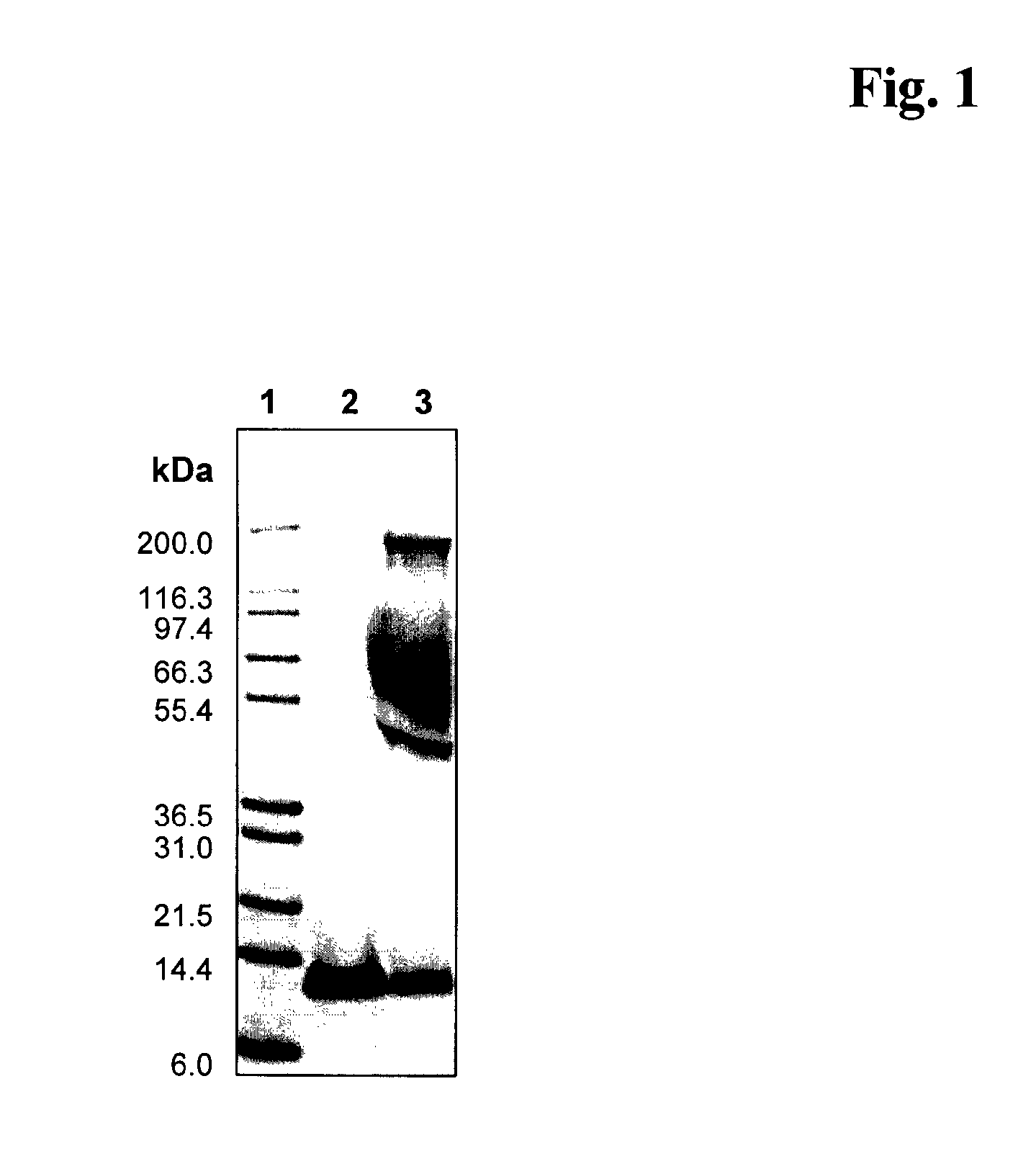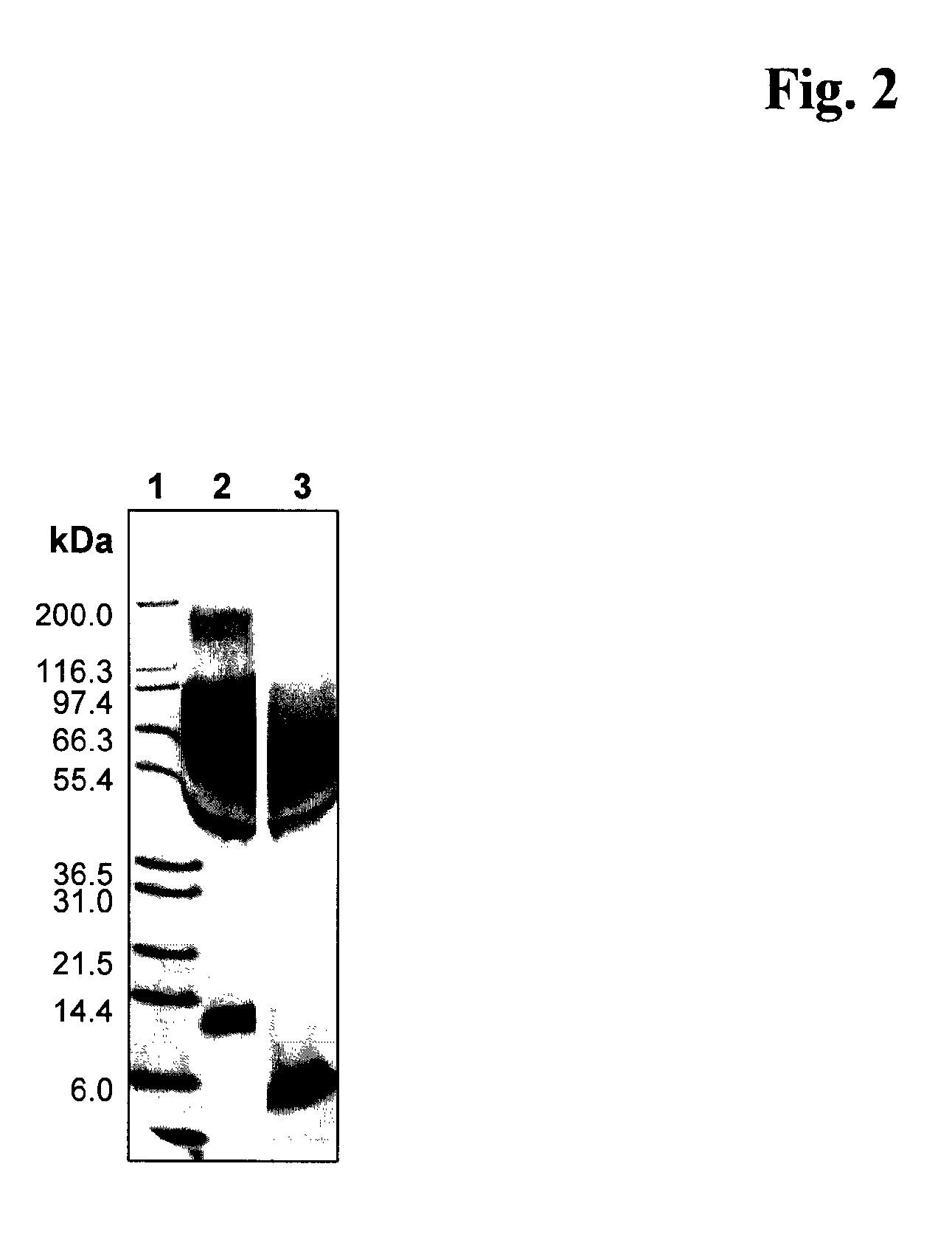Method for the production of conjugates of insulin-like growth factor-1 and poly(ethylene glycol)
a technology of insulinlike growth factor and conjugate, which is applied in the direction of antibacterial agents, drug compositions, peptide/protein ingredients, etc., can solve the problems of unsuitable commercial use of nhs-pegylated proteins, unsuitable igf-i function regulation, and loss of biological activity. , to achieve the effect of improving the expression of fusion proteins
- Summary
- Abstract
- Description
- Claims
- Application Information
AI Technical Summary
Benefits of technology
Problems solved by technology
Method used
Image
Examples
example 1
The Following Mutants (Comprising IGF-I-Variant RRK) with the Propeptides of the animo acid sequence Met-X1-Hisn-X2-Pro-Z were Produced)(PRPP disclosed as SEQ ID NO: 29):
[0095]
MutantX1X2nYPx3036_IAG K27R K65R K68noneKAKRFKKH6PRPP(SEQ ID NO: 2)(SEQ IDNO: 6)Px3036_IAG_R K27R K65R K68noneRARRFRRH6PRPP(SEQ ID NO: 2)(SEQ IDNO: 7)Px3036_IAEE_F1 K27R K65R K68SNTEHNREH6PRPP(SEQ ID NO: 3)(SEQ IDNO: 8)Px3036_IAFX_F1 K27R K65R K68NIEGRH6PRPP(SEQ ID NO: 4)(SEQ IDNO: 9)Px3036_IAFX_F2 K27R K65R K68NTEFENIEH6PRPP(SEQ ID NO: 5)(SEQ IDNO: 10)
Preparation of IGF-I-variant (RRK variant) monoPEGylated at Residue Position 68
[0096]The expression vector and the E. coli strain used are described in EP 0 972 838. From an E. coli clone, expressing fusion protein px3036_IAG_R K27R K65R K68, px3036_IAEE_F1 K27R K65R K68, px3036_IAFX_F1 K27R K65R K68 or px3036_IAFX_F2 K27R K65R K68, grown on selective agar plate, one inoculating loop was transferred to (100 ml) selective medium and cultivated for 13 h at 37° C. ...
example 2
The Following Mutants (Comprising IGF-I-Variant RKR) with the Propeptides of the amino acid sequence Met-X1-Hisn-X2-Pro-Z are Produced):
[0098]
MutantX1X2nYPx3036_IAG K27R K65 K68RnoneKAKRFKKH6PRPP(SEQ ID NO: 22)Px3036_IAG_R K27R K65 K68RnoneRARRFRRH6PRPP(SEQ ID NO: 22)Px3036_IAEE_F1 K27R K65 K68RSNTEHNREH6PRPP(SEQ ID NO: 23)Px3036_IAFX_F1 K27R K65 K68RNIEGRH6PRPP(SEQ ID NO: 24)Px3036_IAFX_F2 K27R K65 K68RNTEFENIEH6PRPP(SEQ ID NO: 25)
Preparation of IGF-I-variant (RKR variant) monoPEGylated at Residue Position 65
[0099]The expression vector and the E. coli strain for use are described in EP 0 972 838. From an E. coli clone, expressing fusion protein px3036_IAG_R K27R K65 K68R, px3036_IAEE_F1 K27R K65 K68R, px3036_IAFX_F1 K27R K65 K68R or px3036_IAFX_F2 K27R K65 K68R, grown on selective agar plate, one inoculating loop is transferred to (100 ml) selective medium and cultivated for 13 h at 37° C. to an optical density (578 nm) of 2-4. This culture is stored on ice for the next 6 hours pri...
example 3
Reduction of Brain Soluble Abeta by IGF-I-Variant RRK MonoPEGylated at Residue Position 68 In vivo
[0101]For evaluation of potency of IGF-I variant RRK monoPEGylated at residue position 68 (40 kD, PEG2) (PEG-RRK) on lowering soluble Abeta levels, 9-10 months old B6152H mice (doubletransgenic mice expressing human APP and PS2 mutants) with heavy amyloid plaque load were repeatedly treated by twice-a-week s.c. injection of 5 μg / kg PEG-RRK.
[0102]Cortical APP, Abeta and Actin levels were detected after 14 days. The APP / actin ratio was not significantly changed by PEG-RRK (FIG. 4A) suggesting that PEG-RRK had no effect on transgene expression over 14 days. In contrast, Abeta / Actin (FIG. 4B) and Abeta / APP (FIG. 4C) ratios were significantly lowered by PEG-RRK. This indicates a positive effect of PEG-RRK on Abeta clearance independent on its production by the transgene.
PUM
| Property | Measurement | Unit |
|---|---|---|
| weight | aaaaa | aaaaa |
| molecular weight | aaaaa | aaaaa |
| total molecular mass | aaaaa | aaaaa |
Abstract
Description
Claims
Application Information
 Login to View More
Login to View More - R&D
- Intellectual Property
- Life Sciences
- Materials
- Tech Scout
- Unparalleled Data Quality
- Higher Quality Content
- 60% Fewer Hallucinations
Browse by: Latest US Patents, China's latest patents, Technical Efficacy Thesaurus, Application Domain, Technology Topic, Popular Technical Reports.
© 2025 PatSnap. All rights reserved.Legal|Privacy policy|Modern Slavery Act Transparency Statement|Sitemap|About US| Contact US: help@patsnap.com



